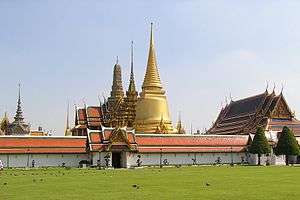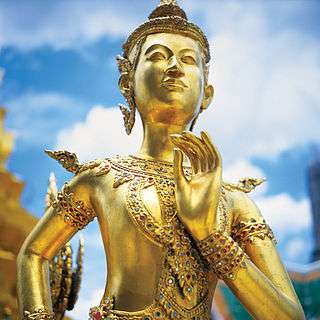Wat Phra Kaew
| Wat Phra Kaew Temple of the Emerald Buddha | |
|---|---|
|
View of Wat Phra Kaew Complex from northeast. | |
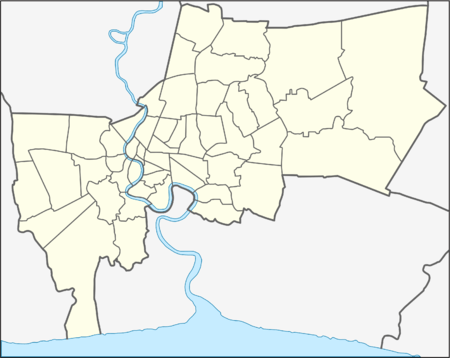 Location within Bangkok | |
| Basic information | |
| Geographic coordinates | 13°45′5″N 100°29′33″E / 13.75139°N 100.49250°ECoordinates: 13°45′5″N 100°29′33″E / 13.75139°N 100.49250°E |
| Affiliation | Theravada Buddhism |
| Country |
Phra Nakhon District, Bangkok, Thailand |
| Architectural description | |
| Founder | King Phutthayotfa Chulalok (Rama I) |
| Completed | 18th Century |
Wat Phra Kaew (Thai: วัดพระแก้ว, rtgs: Wat Phra Kaeo, IPA: [wát pʰráʔ kɛ̂ːw], Pronunciation, English: Temple of the Emerald Buddha; full official name Wat Phra Si Rattana Satsadaram, Thai: วัดพระศรีรัตนศาสดาราม, IPA: [wát pʰráʔ sǐː rát.ta.náʔ sàːt.sa.daː.raːm]) is regarded as the most sacred Buddhist temple (wat) in Thailand. The temple complex is located in the Phra Nakhon District of Bangkok.
Description
The Emerald Buddha housed in the temple is a potent religio-political symbol and the palladium (protective image) of Thai society.[1][2] It is located in Phra Nakhon District, the historic centre of Bangkok, within the precincts of the Grand Palace.[3][4]
The main building is the central phra ubosot, which houses the statue of the Emerald Buddha. According to legend, this Buddha image originated in India where the sage Nagasena prophesized that the Emerald Buddha would bring "prosperity and pre-eminence to each country in which it resides", the Emerald Buddha deified in the Wat Phra Kaew is therefore deeply revered and venerated in Thailand as the protector of the country. Historical records however dates its finding to Chiang Rai in the 15th century where, after it was relocated a number of times, it was finally taken to Thailand in the 18th century. It was enshrined in Bangkok at the Wat Phra Kaew temple in 1782 during the reign of Phutthayotfa Chulalok, King Rama I (1782–1809). This marked the beginning of the Chakri Dynasty of Thailand, whose present sovereign is Vajiralongkorn, King Rama X.
The Emerald Buddha, a dark green statue, is in a standing form, about 66 centimetres (26 in) tall, carved from a single jade stone ("emerald" in Thai means deep green colour and not the specific stone). It is carved in the meditating posture in the style of the Lanna school of the northern Thailand. Except for the Thai King and, in his stead, the Crown Prince, no other persons are allowed to touch the statue. The King changes the cloak around the statue three times a year, corresponding to the summer, winter, and rainy seasons, an important ritual performed to usher good fortune to the country during each season.[2][3][4]
History


In 1767, the Kingdom of Ayutthaya fell to the Burmese, and King Taksin then moved the capital to Thonburi where he built the old palace beside Wat Arun on the west bank of Chao Phraya River. In 1778, Taksin's army under the command of Chao Phraya Chakri (who later became Rama I) captured Vientiane and took the Emerald Buddha back to Thonburi.
In 1782, King Rama I succeeded to the throne and founded the Chakri Dynasty, and he decided to move the capital across the river to Bangkok as it would be better protected from attack.[5] The site chosen for the palace is situated between two old wats, Wat Pho and Wat Mahathat, an area inhabited by Chinese residents who were then moved to the present Chinatown.[6] He started the construction of the Grand Palace so that the palace may be ready for his coronation in 1785. Wat Phra Kaew, which has its own compound within the precinct of the palace, was built to house the Emerald Buddha, which is considered a sacred object that provides protection for the kingdom. Wat Phra Kaew was completed in 1784.[1][7] The formal name of Wat Phra Kaeo is Phra Sri Rattana Satsadaram, which means "the residence of the Holy Jewel Buddha."
Wat Phra Kaew has undergone a number of renovations, restoration and additions in its history, particularly during the reign of King Rama III and Rama IV. Rama III started the renovations and rebuilding in 1831 for the 50th Anniversary of BangkoK of 1832, while Rama IV's restoration was completed by Rama V in time for the Bangkok Centennial celebrations in 1882. Further restoration was undertaken by Rama VII on Bangkok's 150th Anniversary in 1932, and by Rama IX for the 200th Anniversary in 1982.[1]
Emerald Buddha
It is not known when the statue of the Emerald Buddha was made, but it is generally believed that it was crafted in 14th-century Thailand.[4] However, there are also claims that the statue originated in India or Sri Lanka.[8] None of these theories can be firmly established as none of the historians could get a close look at the statue.[2][4]
According to one account, the Emerald Buddha was found in Chiang Rai, Lanna in 1434, after a lightning storm struck a temple. The Buddha statue fell down and later became chipped, and the monks, after removing the stucco around the statue, discovered that the image was a perfectly made Buddha image from a solid piece of green jade. The image was moved a few time to various temples, first to Lampang, then to Chiang Mai, from where it was removed by prince Chao Chaiyasetthathirat to Luang Prabang, when his father died and he ascended the throne of both Lanna and Lan Xang, in 1551. The statue remained the it to his new capital of Lan Xang in Vientiane in the 1560s. The statue remained there for twelve years. King Chaiyasetthathirat then shifted it to his new capital of Lan Xang in Vientiane in the 1560s. He took the Emerald Buddha with him and the image remained in Vientiane for 214 years until 1778.[8]
In the reign of King Taksin, Chao Phya Chakri (who later became Rama I) defeated Vientiane and moved the Emerald Buddha from Vientiane to Thonburi where it was installed in a shrine close to Wat Arun. When Chao Phra Chakri took over the throne and founded the Chakri Dynasty of the Rattanakosin Kingdom, he shifted his capital across the river to its present location in Bangkok. The Emerald Buddha was also moved across the river with pomp and pageantry and installed in the temple of Wat Phra Keaw.[2][4]
Legends


There a number of legends associated with the Emerald Buddha. It was said the iconic image of the Emerald Buddha was made by Nagasena, a saint in Pataliputra (present day Patna), India, who, with the help of Hindu god Vishnu and demigod Indra, had the Emerald Buddha image made. Nagasena predicted that:[2]
The image of the Buddha is assuredly going to give to religion the most brilliant importance in five lands, that is in Lankadvipa (Sri Lanka), Ramalakka, Dvaravati, Chieng Mai and Lan Chang (Laos).
The Emerald Buddha image was taken to Sri Lanka after three hundred years in Pataliputra to save it during a civil war. In 457, King Anuruth of Burma sent a mission to Ceylon with a request for Buddhist scriptures and the Emerald Buddha, in order to promote Buddhism in his country. These requests were granted, but the ship lost its way in a storm during the return voyage and landed in Cambodia. When the Thais captured Angkor Wat in 1432 (following the ravage of the bubonic plague), the Emerald Buddha was taken to Ayutthaya, Kamphaeng Phet, Laos and finally Chiang Rai, where the ruler of the city hid it, and was later found.[2]
Architecture
Wat Phra Kaew has a plethora of buildings within the precincts of the Grand Palace, which covers a total area of over 94.5 hectares (234 acres). It has over 100 buildings with “200 years royal history and architectural experimentation” linked to it. The architectural style is named as Rattanakosin style (old Bangkok style). The main temple of the Emerald Buddha is very elegantly decorated and similar to the temple in ancient capital of Ayudhya. The roof is embellished with polished orange and green tiles, the pillars are inlaid in mosaic and the pediments are made of rich marble, installed around 18th century. The Emerald Buddha is deified over an elevated altar surrounded by large gilded decorations. While the upper part of this altar was part of the original construction, the base was added by King Rama III. Two images of the Buddha, which represent the first two kings of the Chakri dynasty, flank the main image. Over the years, the temple has retained its original design. However, minor improvements have been effected after its first erection during Rama I's reign; wood-work of the temple was replaced by King Rama III and King Chulalongkorn; during King Mongkut's reign, the elegant doors and windows and the copper plates on the floor were additions, Rama III refurbished the wall painting (indicative of the universe according to Buddhist cosmology) and several frescoes that display the various stages of the Buddha's life; three chambers were added on the western side by King Mongkut; in the chamber known as 'Phra Kromanusorn' at the northern end, images of Buddha have been installed in honour of the kings of Ayutthaya; and in the 19th century, Khrua In Khong, a famous painter executed the wall murals. The entry to the temple is from the third gate from the river pier.[2][4][9][10][11][12][13]

The entrance is guarded by a pair of yakshis (mythical giants – 5 metres (16 ft) high statues). The eponymous image Buddha in brilliant green colour is 66 centimetres (26 in) in height with a lap width of 48.3 centimetres (19.0 in). It is carved in a yogic position, known as Virasana (a meditation pose commonly seen in images in Thailand and also in South India, Sri Lanka and Southeast Asia). The pedestal on which the Emerald Buddha deified is decorated with Garuda (the mythical half-man half-bird form, a steed of Rama, who holds his mortal enemy Naga the serpent in his legs) motifs It is central to Thai Buddhism. The image made with a circular base has a smooth top-knot that is finished with a "dulled point marking at the top of the image". A third eye made in gold is inset over the elevated eyebrows of the image. The image appears divine and composed, with the eyes cast downward. The image has a small nose and mouth (mouth closed) and elongated ears. The hands are seen on the lap with palms facing upwards.[2][11][14]

The entire complex, including the temples, is bounded by a compound wall which is one of the most prominent part of the wat is about 2 kilometres (6,600 ft) length. The compound walls are decorated with typically Thai murals, based on the Indian epic Ramayana. In Thai language these murals are known to form the Ramakian, the Thai national epic, which was written during the reign of Rama I. The epic stories formed the basic information to draw the paintings during the reign of King Rama I (1782–1809). These paintings are refurbished regularly. The murals, in 178 scenes, starting with the north gate of the temple illustrates the complete epic story of Ramayana sequentially, in a clockwise direction covering the entire compound wall. The murals serve to emphasise human values of honesty, faith, and devotion.[2][4][9][12]
There are twelve salas that were built by Rama I, around the temple. They house interesting artefacts of regions such as Cambodia and Java. One of these salas had an inscription of Ramkamhaeng, which was shifted, in 1924, to the National Library. During the reign of King Mongkut, the Phra Gandharara – small chapel on the southwest corner – and a tall belfry were new additions.[2]
Worship and ceremonies
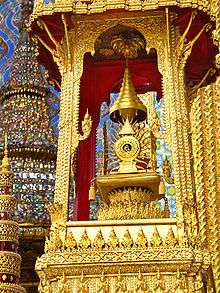
Early in the Bangkok period, the Emerald Buddha used to be taken out of its temple and paraded in the streets to relieve the city and countryside of various calamities (such as plague and cholera). However, this practice was discontinued during Rama IV's reign as it was feared that the image could get damaged during the procession and also a practical line of thinking that Rama IV held "that diseases are caused by germs, not by evil spirits or the displeasure of the Buddha". The image also marks the changing of the seasons in Thailand, with the king presiding over the seasonal ceremonies.[2]
Like many other Buddha statues in Thailand, the Emerald Buddha is dressed in a seasonal costume. It is a significant ritual held at this temple. In this ritual, dress of the deity is changed three times a year to correspond to the seasons. In summer it is a pointed crown of gold and jewels, and a set of jewelled ornaments that adorns the image from the shoulders to the ankles. In winter, a meshed dressing gown or drapery made of gold beads, which covered from the neck down like a poncho is used. During the rainy months, a top-knot headdress studded with gold, enamel and sapphires; the gold attire in the rainy season is draped over the left shoulder of the deity, only with the right shoulder left bare while gold ornaments embellish the image up to the ankles. The astrological dates for the ritual ceremonies, at the changing of the seasons, followed are in the 1st Waning Moon of Lunar Months 4, 8 and 12 (around March, July and November). The costume change ritual is performed by the Thai king who is the highest master of ceremonies for all Buddhist rites. On each occasion, the king himself "cleans the image by wiping away any dust that has collected and changing the headdress of the image". Then a king's royal attendant climbs up and performs the elaborate ritual of changing garments of the image as the king is chanting prayers to the deity. On this occasion, the king sprinkles water over the monks and the faithful who have assembled to witness the unique ritual and seeks blessings of the deity for good fortune during the upcoming season. The two sets of clothing not in use at any given time are kept on display in the nearby Pavilion of Regalia, Royal Decorations and Coins in the precincts of the Grand Palace. While Rama I initiated this ritual for the hot season and the rainy season, Rama III introduced the ritual for the winter season.[2][4] The robes, which the image adorns, represents that of monks and King's depending on the season, a clear indication of highlighting its symbolic role "as Buddha and the King", which role is also enjoined on the Thai King who formally dresses the Emerald Buddha image.[14]
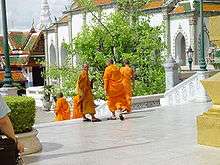
A ceremony that is observed in the wat is the Chakri Day (begun on April 6, 1782), a national holiday to honour founding of the Chakri dynasty. On this day, the king attends the ceremony. The present king Rama IX, with his Queen, and entourage of the royal family, the Prime Minister, officials in the Ministry of Defence, and other government departments, first offer prayers at the Emerald Buddha temple. This is followed by visit to the pantheon to pay homage to the images of past Chakri rulers that are installed there.[2]
The coronation ceremony, which marks the crowning of the king, is an important event of the Chakri dynasty. One such recent event took place when the present Rama IX was crowned the King. On this occasion, the King came to the Chapel Royal- the Wat Phra Keo – in a procession wearing a 'Great Crown'. After entering the chapel, the king made offerings of gold and silver flowers to the deity and also lighted candles. He also paid homage to the images of Buddha that represented the past kings of the dynasty. In the presence of assembled elite clergy of the kingdom, he took a formal vow of his religion and his steadfastness to 'Defend the Faith'.[2]
Rules of entry and conduct
The sacred temples in Thailand follow a dress code, which is strictly followed. Men must wear long pants and sleeved shirts and shoes; women must wear long skirts. Visitors who arrive dressed otherwise may rent appropriate clothing items at the entry area of the temple. It is compulsory to remove the shoes before entering the temple, as a sign of respect of the Buddha, as is the practice in all other temples in Thailand. While offering prayers before the Buddha image, the sitting posture should avoid any offensive stretching of feet towards the deity; the feet should be tucked in towards the back.[9]
Other monuments
While the surrounding portico of the shrine is an example of Thai craftsmanship, the perimeter of the temple complex has 12 open pavilions. These were built during the reign of Rama I.[4] There is plethora of monuments in the temple complex. These are:
- Grand Palace
.jpg)
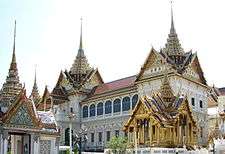
The former residence of the King, the Grand Palace, adjoins the temple. The King makes use of this Grand Palace for ceremonial functions such as the Coronation Day. The King’s present residence is to the north of this Grand Palace and is known as the Chitlada Palace. The four structures surrounding the temple have history of their own. At the eastern end is the Borombhiman Hall (built in French architectural design), which was the residence of King Rama VI, now used as guest house for visiting foreign dignitaries. It has the dubious distinction of having been used as the operational headquarters and residence of General Chitpatima who attempted a coup, in 1981. The building to the west is the Amarindra hall, earlier a hall of Justice, now used for formal ceremonies. The Chakri Mahaprasat is the largest hall in the Grand Palace, built in 1882 by British architects, the architecture of which is fusion of Italian renaissance and Traditional Thai architecture. This style is called farang sai chada, (meaning: "Westerner wearing a Thai crown") as each wing has a shrine (mandap) crowned by a spire. Ashes of the Chakri kings (five ancestors) are enshrined in the largest of these shrines, also known as the pantheons, that were rebuilt after a fire in 1903 during Rama IV's reign. Ashes of the Chakri princess who could not become kings are enshrined in an adjoining hall. The throne room and the reception hall are on the first floor, while the ground floor houses a collection of weapons. The inner palace had the King’s harem (the practice was discontinued during King Rama VI's time who decreed the one wife rule), which was guarded by well trained female guards. Another hall in the palace is the 'Dusit hall' in Ratanokosin-style, which runs from east to west, which was initially an audience hall but now converted into a funerary hall for the Royal family. Royal family corpses are kept here for one year before they are cremated in a nearby field. There is also a garden which was laid during rama IV's reign. The garden depicts a "Thai mountain-and-woods-fable" mountain scenes where the coming of age ritual of shaving the topknot of the Prince is performed.[2][9][15]
- Pagodas
The temple grounds also depict three pagodas to its immediate north, which represent the changing centres of Buddhist influence. One such shrine to the west of the temple is the Phra Si Ratana Chedi, a 19th-century stupa built in Sri Lankan style enshrining ashes of the Buddha.[4]
- Library
.jpg)
Rama I also built a library in Thai style, in the middle of the complex, known as the "Phra Mondop". The library houses an elegantly carved Ayutthaya-style mother-of-pearl doors, bookcases with the Tripitaka (sacred Buddhist manuscripts), human-and dragon-headed nagas (snakes), and images of Chakri kings.[4]
During the 19th century, the Royal Pantheon was built in Khmer style to the east of the temple, which is kept open for only one day in year, in the month of October to commemorate the founding of the Chakri dynasty.[4]
- Model of Angkor Wat
The temple complex also contains a model of Angkor Wat (the most sacred of all Cambodian shrines). In 1860, King Mongkut ordered his generals to lead 2,000 men to dismantle Angkor Wat and take it to Bangkok. Modern scholars suggested that the king wanted to show that Siam was still in control of Cambodia, as France was seeking to colonise Cambodia at that time. However, the king's order could not be fulfilled. A royal chronicle written by Lord Thiphakorawong (Kham Bunnag), then foreign minister, recorded that many Thai men fell ill after entering Cambodian wilderness. The chronicle also stated that forest-dwelling Khmer people ambushed the Thai army, killing many leading generals. King Mongkut then ordered the construction of the model within Wat Phra Kaew, instead of the real Angkor Wat that could not be brought to Bangkok. Mongkut died before he could see the model. Its construction was completed in the reign of his son, Chulalongkorn.[16]
- Hermit statue
A hermit's bronze image, which is believed to have healing powers, is installed in a sala on the western side of the temple. It is near the entry gate. It is a black stone statue, considered a patron of medicine, before which relatives of the sick and infirm pay respects and make offerings of joss sticks, fruit, flowers, and candles.[2][4]
- Eight towers
On the eastern side of the temple premises there are eight towers or prangs, each of a different colour. They were erected during the reign of Rama I and represent eight elements of Buddhism.[17]
- Elephant statues
Statues of elephants, which symbolize independence and power, are seen all around the complex. As Thai kings fought wars mounted on elephants, it has become customary for parents to make their children circumambulate the elephant three times with the belief that it would bring them strength. The head of an elephant statue is also rubbed for good luck; this act of the people is reflected in the smoothness of the surface of elephant statues here.[4]
Map
| Map of Wat Phra Kaew | ||
|---|---|---|
.svg.png) |
|
|
| ||
Gallery
 A Wat Phra Kaew Inner Compound Structure
A Wat Phra Kaew Inner Compound Structure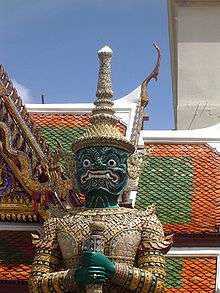 Thotsakhirithon (ทศคีรีธร), giant demon (Yaksha) guarding an exit to Grand Palace
Thotsakhirithon (ทศคีรีธร), giant demon (Yaksha) guarding an exit to Grand Palace Kinare – mythological creature, half bird, half man
Kinare – mythological creature, half bird, half man Detail of a kinnara-statue
Detail of a kinnara-statue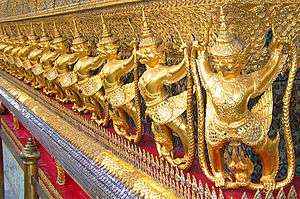
- Nok Tantima (นกตันติมา) or Tantima bird, guarding the Viharn Yod
- Wat Phra Kaew from entrance
- Phra Mondop (the library) and Phra Sri Rattana Chedi
 Nāga at the entrance to Phra Mondop
Nāga at the entrance to Phra Mondop Entrance to Phra Mondop
Entrance to Phra Mondop- View of the Temple of Emerald Buddha and Golden Stupa
 Royal Pantheon of Wat Phra Kaew
Royal Pantheon of Wat Phra Kaew- A row of prangs in Wat Phra Kaew
See also
| Wikimedia Commons has media related to: |
- Wat Pho (Temple of the Reclining Buddha)
References
- 1 2 3 Pasit Charoenwong, ed. (1982). The Sights of Rattanakosin. Committee for the Rattanakosin Bicentennial Celebration. ISBN 978-9747919615.
- 1 2 3 4 5 6 7 8 9 10 11 12 13 14 15 16 "Explorations in Southeast Asian Studies: The Origin and Significance of the Emerald Buddha" (PDF). A Journal of the Southeast Asian Studies Student Association. 1999. Retrieved 2014-09-22.
- 1 2 "Bangkok Wat Phra Kaew:The Emerald Buddha". Asia Web (Direct). Retrieved 2010-03-27.
- 1 2 3 4 5 6 7 8 9 10 11 12 13 14 "Wat Phra Kaew, Bangkok". Sacred Destinations. Retrieved 2010-03-27.
- ↑ Dan Waites (2014). CultureShock! Bangkok. Marshall Cavendish Editions. p. 22. ASIN B00J48FSII.
- ↑
- O'Neil, Maryvelma Smith (2008). Bangkok: a cultural history. New York: Oxford University Press. pp. 134–135. ISBN 978-0-19-534251-2.
- ↑ "Wat Phra Si Rattanasatsadaram or Wat Phra Kaeo, Bangkok". Encyclopedithai.org.
- 1 2 M.C. Subhaddradis Diskul. "The History of the Temple of the Emerald Buddha". Asian Institute of Technology.
- 1 2 3 4 Williams, China; Aaron Anderson; Brett Atkinson; Becca Blond; Tim Bewer (2010). Thailand. Lonely Planet. p. 126. ISBN 9781742203850. Retrieved 2010-03-27.
- ↑ Cummings, Joe; China Williams (2004). Bangkok. Lonely Planet. pp. 78–79. ISBN 1-74059-460-6. Retrieved 2010-03-28.
- 1 2 Thailand year book. Temple Publicity Services., 1968. p. 75. Retrieved 2010-03-28.
- 1 2 "Wat Phra Kaeo". Thailand Photos. Retrieved 2010-03-27.
- ↑ Brockman, Norbert C. (2011). Encyclopedia of Sacred Places. California: ABC-CLIO, LLC. pp. 73–74. ISBN 978-1-59884-655-3.
- 1 2 Kleiner, Fred. S.; Christin J. Mamiya (2009). Gardner's Art Through the Ages: Non-Western Perspectives. Cengage Learning. pp. 42–43. ISBN 0-495-57367-1. Retrieved 2010-03-28.
- ↑ Agar+first=Charles (2006). Frommer's Thailand. John Wiley and Sons. pp. 133–134. ISBN 0-471-78470-2. Retrieved 2010-03-28.
- ↑ Charnvit Kasetsiri (2009). โปรดให้รื้อปราสาทขอม [Relocating a Khmer temple] (pdf) (in Thai). Bangkok: Foundation for the Promotion of Social Sciences and Humanities Textbooks Project. pp. 3–4.
- ↑ Kindersley Dorling, Philip Cornwel-Smith (1 August 2012). Thailand. Dorling Kindersley. p. 83. ISBN 978-1405370691.
